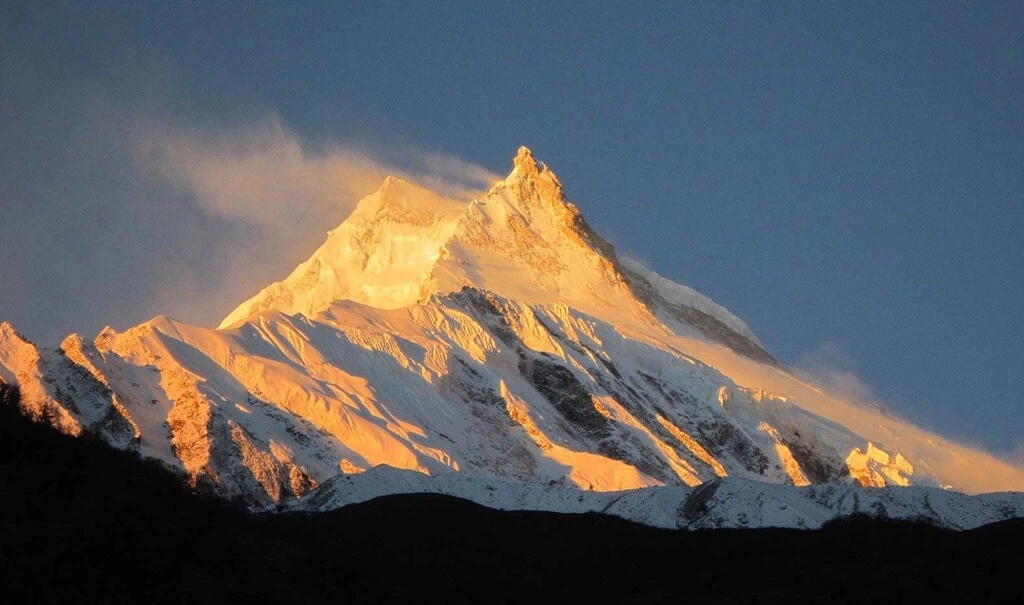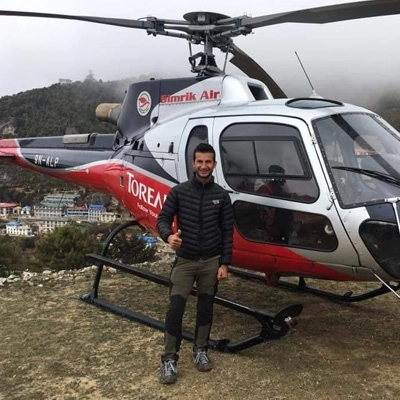Manaslu Expedition Description
Manaslu Expedition has long been an adventurous voyage to the eighth-highest mountain in the world, a dream of mountaineers. Mt. Manaslu, at 8,163 metres above sea level, gained the reputation as the name "Mountain of Spirit" and gave easy access to the terrifying class of 8000-metre peaks. It is considered one of the easier 8,000-metre mountains and, hence, popular among those trying to break into high-altitude mountaineering. Manaslu lies in west-central Nepal within the Himalayas. Manaslu Expedition is far more than a simple climb; this is technically a combination of deep wilderness trekking and mountaineering in the Himalayas. The Manaslu trek cuts across the Manaslu Conservation Area, where one can see manifold flora and fauna in the Himalayas, high-altitude settlements, and different landscapes marked by rivers, waterfalls, and breathtaking views. This has got to be one of the least travelled, off-the-beaten-path treks that give peeks into Nepal's rich cultural heritage and virgin natural beauty.
Climbing Manaslu is challenging but rewarding. Even though there are some technical sections on the regular route, the regular route is considered comparatively straightforward in comparison to other peaks in the same altitude class. Normally, this is a very good time of year for the expedition: autumn brings clear skies, good weather, and fewer climbers, especially during September. Although many climbers reach the fore summit of Manaslu, few achieve the true summit because of the tricky ridge connecting the two. Starting from the rich history with the first ascent in 1956 by T. Imanishi of Japan and Sherpa Gyalzen Norbu, today there are various routes that reach the summit of Manaslu, each with different approaches toward reaching your goal. Manaslu is also the most famous acclimatisation mountain for Everest and the most popular alternative to Cho Oyu.
Highlights of Manalsu Peak Climbing
- Scale Mt. Manaslu, the "Mountain of Spirit," towering at 8,163 metres, the world's eighth-highest peak.
- Compared with other 8,000-metre peaks, Manaslu is less technical; therefore, it is a good candidate for a first 8,000-metre experience among climbers.
- Besides the climb, an opportunity is afforded to pass through traditional Buddhist villages, ancient monasteries, and Tibetan-influenced culture for added depth in the expedition.
- Be witness to Himalayan giants Ganesh Himal, Annapurna, and the Langtang range, with amazing views of lush valleys and alpine forests.
- Get ready to enter Manaslu Conservation Area, home to the seldom-seen flora and fauna of the Himalayas: blue sheep, snow leopards, and a wide variety of birds.
- Test your stamina across varied landscapes, starting from dense forests up to steep ridges and snowy peaks.
- Get an all-rounded Himalayan climbing experience.
- The trek over Larkya La Pass, along with a gradual ascent, enables good acclimatisation.
- Variety of routes: There were various routes to the top of the mountain in order to give options and alternatives to the climbers as per their experience and preference.
- Generally considered a training climb for Everest, Manaslu has been considered an excellent development compared to other high-altitude expeditions.
Mount Manaslu Facts
Category | Details |
Mountain Height | 8,163 metres (26,781 feet) |
Location | Mansiri Himal, Nepal |
Rank | 8th highest peak in the world |
First Ascent | May 9, 1956 by Toshio Imanishi and Gyalzen Norbu |
Climbing Season | Spring (March-May) and Fall (September-November) |
Average Summit Time | 45-50 days for full expedition |
Success Rate | Approximately 60-65% in good conditions |
Death Rate | Around 2% (one of the lower rates among 8000m peaks) |
Local Name Meaning | "Mountain of the Spirit" in Sanskrit |
Geographical Features | 4 separate summits, Long ridges and glacier valleys, Several glacial lakes |
Technical Difficulty | Moderate compared to other 8000m peaks |
Base Camp Altitude | 4,800 metres (15,748 feet) |
Number of Camps | Generally 4 camps above base camp |
Who Can Attempt to Climb Mount Manalsu?
Mt. Manaslu is considered the more accessible 8,000-metre peak. It serves best for the experience of climbing peaks in the 6,000-7,000 metres range and wishing to ascend at higher elevations. You must be in the best physical state and able to endure eight hours of constant climbing and trekking per day. They are expected to have experience with technical climbing equipment, be sure footed on both ice and rock and have experience at high altitudes. The thin air is grievous even to the most seasoned climber. They should be sound in glacier travel, rope skills, and crampon techniques. Manaslu is often considered to be as technically demanding as Cho Oyu but offers far more varied routes and can be considered as great preparation for higher, serious peaks like Everest. Any aspiring climber should also mentally prepare themselves for extended periods at altitude and the patience that will be required while waiting for suitable weather windows.
What Are The Benefits of Manaslu Expedition Packages With Us?
- Fully guided expedition, including support from certified mountain guides.
- The elite Sherpa climbing support team has experience and knowledge in high-altitude climbing and local conditions in Manaslu.
- Full assistance for airport arrivals, including international and domestic airport transfers.
- Full Manaslu route maps and a comprehensive climbing strategy will be detailed during briefings.
- Health monitoring equipment: oximeters, regular health check-ups by experienced staff.
- Fully equipped medical kit and first-aid trained staff throughout the expedition.
- Top quality camping equipment. Using only the most comfortable and super 'A' graded extreme weather tents.
- Wholesome and nutritious meals to keep up the energy prepared by our expert high-altitude cooks.
- Communication support: You can contact your loved ones back home with a local SIM card.
- Full modern basecamp facilities include a dining tent, communication tent, and toilet facilities.
- We will organise all climbing permits and documents required from our side, which our professional team will manage.
- Pre-climb training sessions and instruction about acclimatisation by professional guides
- Arrangement and coordination of emergency evacuation, if necessary
Your Adventure Altitude Treks Team and Sherpas For Manaslu Climbing
Our team of mountaineers is among the most talented and well-respected climbers in the world. Our climbing Sherpas have each reached the summit of Manaslu many times before, and you will be hard-pressed to find a more experienced, friendly, or supportive team of climbing guides anywhere in the Himalayas. In addition to being International Federation for Mountain Guides Association (IFMGA) certified, our lead climbing Sherpas are veteran mountaineers who know Manaslu’s routes, weather patterns and technical challenges intimately.
Many teams on Manaslu work with inexperienced or simply less-accomplished local outfitters who subcontract their service out to other western guide services if they receive booking interest, but we would put our staff up against anyone on the mountain for their skill level as climbers AND service providers! They are also renowned for their unmatched hospitality and incredible teaching skills and have a proven track record for effectively fostering team spirit on an expedition. We are absolutely committed to responsible and sustainable tourism practices wherever we trek and climb - our Sherpa Team is at the forefront of this effort, ensuring that during every trip, we leave nothing behind but footsteps.
Notable Features of the Mount Manalsu
- Less crowded than Everest: Manaslu is nowhere near being as crowded in comparison to other busier peaks such as Everest. It offers climbers a more subliminal atmosphere during their quest to conquer the mountain.
- Manaslu presents more variability in climbing challenges and hence offers more technical variation compared to Cho Oyu, thereby presenting more adventure to an experienced climber.
- Ideal for Everest Preparation: Manaslu is utilised as a training peak by many climbers, and it is taken as an acclimatisation ground for those preparing expeditions to Everest and other high-altitude expeditions.
- At 8,163 metres, Manaslu is the eighth-highest mountain in the world but offers substantially fewer challenges compared with higher peaks and thus provides a very popular target for those wishing to climb an 8,000-metre peak.
- The road to Manaslu Trek goes through the traditional Tibetan-influenced village, and the interesting culture-trail tour adds more richness due to the existence of Buddhist monasteries.
- Ecologically diverse because it takes one to the well-protected areas of Manaslu Conservation Area, replete with varieties of rare Himalayan flora and fauna. A factor that gives an ecological dimension to the adventure.
- At least six routes are recognized as established on Manaslu, accounting for various approaches about skill and conditions.
Manaslu Expedition Cost 2025 and 2026
The Manaslu Expedition in 2025 and 2026 cost between $8,000 to $15,000 per head. The full cost really depends upon group size, services involved, and company chosen. The estimated cost breakdown for upcoming years could look something like this:
Manaslu Expedition Cost 2025: $8,000 to $15,000 per person
Manaslu Expedition 2026 Cost: $8000-$15000 per person
We are flexible and can fix the Manaslu Expedition itinerary according to the convenience of the clients. It may be by adding more extra days for acclimatisation or even making changes in the routes depending on your experience and requirements. Note that every customization of the itinerary might affect the full cost of your expedition.


